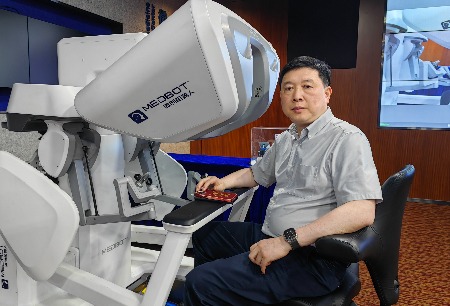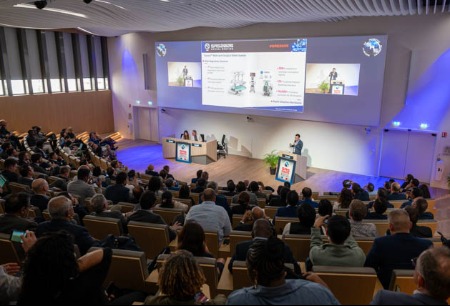Qujing, Yunnan --- A robot-assisted total knee arthroplasty (TKA) has been successfully completed in Qujing Second People's Hospital recently by the team led by Bing Yang, director of Orthopedic Department I of the hospital with Honghu Orthopedic Surgical Robot ("Honghu") independently developed by MicroPort NaviBot(Suzhou)Co., Ltd., Ltd., a subsidiary of Shanghai MicroPort MedBot (Group) Co., Ltd. Qujing Second People's Hospital is the originator of laparoscopy of China, where the first case of laparoscopic cholecystectomy of China was conducted, thus honored as the "Birthplace of minimally invasive surgery of China". Over the years, it has been keeping the pace with the times, constantly innovating in inheritance and taking the lead in developing knee arthroscopic surgery in Qujing City with its advantages of minimally invasive endoscopic surgery, and has opened up the intelligent era of orthopedic robot surgery. The Orthopedics Department of the hospital is the sub-center of Yunnan MicroPort®MedBot® Multi-Center Research Team and expects to use better technology to serve patients and provide them with the higher quality medical experience.
The patient of the case, a 55-year-old woman with osteoarthritis suffered the pain of knee joint all the year round, which seriously affected her daily life and walking.
She came to Qujing Second People's Hospital specially for diagnosis after learning about its orthopedic surgery robot technology. After careful assessment, analysis and discussion of the patient's condition, Director Bing Yang and his team worked out a set of accurate personalized surgical plan, and performed the CT 3D reconstruction of the patient's knee joint through the robot system. The human-computer interactive surgical platform of Honghu (Honghu HCI Platform) guided the robotic arm registration and bone registration nimbly during the surgery, the robotic arm accurately positioned the pre-planned position, assisted in the osteotomy of femur and tibia. Compatible with the MicroPort®Orthopedics medial-pivot knee system, the whole operation was completed smoothly and efficiently.
Postoperative measurement shows that the actual osteotomy is completely consistent with the planned value. The patient recovered fast after the operation, and the lower limb showed that the force line had been accurately restored, which proved the precise characteristics of Honghu.
Professor Bing Yang, the chief orthopedic expert of Orthopedics Department I of Qujing Second People's Hospital, said: "For knee joint replacement surgery, the lower limb force line, osteotomy amount, prosthesis placement angle and soft tissue balance are decisive factors that affect the surgical effect and the expected life of prosthesis. In a traditional operation mode, the artificial locating tools are used to determine the osteotomy amount, locate the position of prosthesis and restore the lower limb force line, but different doctors have different operation habits. Thus an error of 1 to 2mm may occur. But such errors can be avoided in a robot-assisted surgery. Before operation, the doctor inputs the CT data of the whole lower limb of patient into the robot system to build models and work out surgical plans through the robot system according to anatomy and characteristics of the patient. The surgical team previews the surgical plans provided by the robot system to get the best operation and navigation effect. During the surgery, with the assistance of robotic arm, the error of lower limb force line and prosthesis angle is accurately controlled within 1 mm or 1° as preoperatively planned, which has truly realized precision and minimal invasion, so that the patients can obtain a better curative effect and greater benefit.”









 Hu ICP Bei No. 20013662 HGWA Bei No. 31011502015178
Hu ICP Bei No. 20013662 HGWA Bei No. 31011502015178 " are registered trademarks of Shanghai MicroPort Medical (Group) Co., Ltd.” . They have been authorized to be used by Shanghai Microport Medbot (Group) Co., Ltd., and no other party shall use such trademarks without prior written permission thereof.
" are registered trademarks of Shanghai MicroPort Medical (Group) Co., Ltd.” . They have been authorized to be used by Shanghai Microport Medbot (Group) Co., Ltd., and no other party shall use such trademarks without prior written permission thereof.
